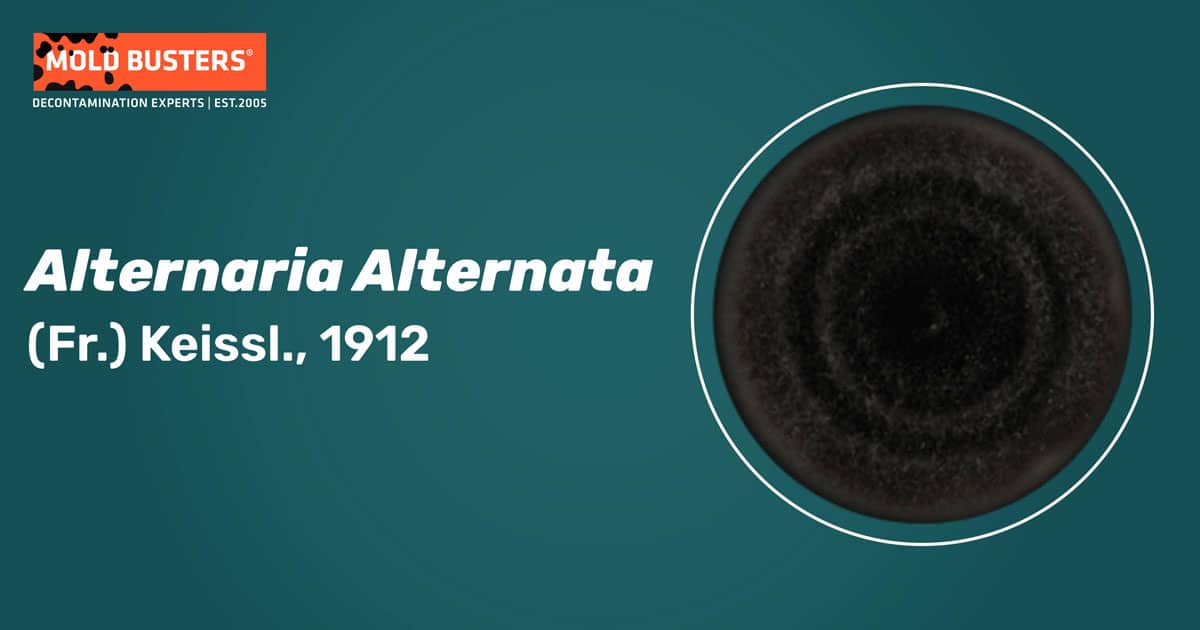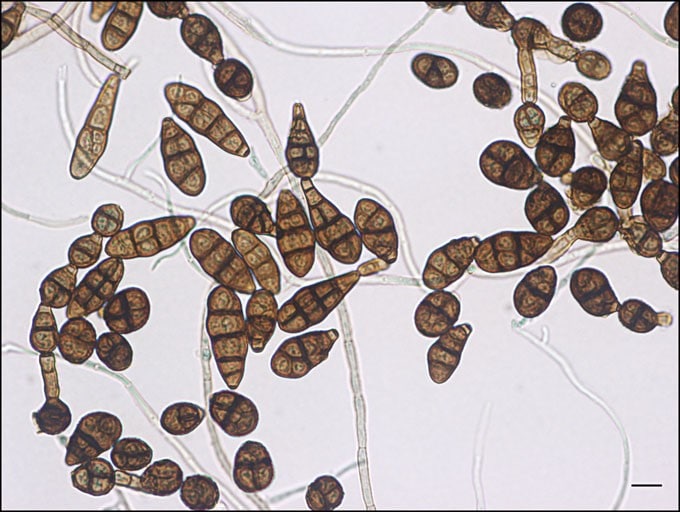(Fr.) Keissl., 1912
What is Alternaria alternata?
Alternaria alternata is one of the most studied fungi due to its impact on us both as an allergen and a phytopathogen [1]. It belongs to the section Alternata within the genus Alternaria, family Pleosporaceae, and phylum Ascomycota. [2,3]. It was originally discovered in 1817 by Nees, under the name Alternaria tenuis, but renamed in A. alternata by Keissler in 1912 [2,4]. A. alternata is a ubiquitous fungus and occurs in various environments. It could be a saprophyte in plants debris, soil, and groceries, or it could be a parasite- infecting plants, animals, and humans [4].

As a plant pathogen, A. alternata has a large number of hosts and is one of the most important fungi causing postharvest decay. It usually creates symptoms as black rot, black spot, stem-end rot, or browning, while apple fruit can also cause moldy core and core rot. As a human pathogen, it is a common cause of respiratory allergies, allergic rhinitis, asthma, and alternariosis, mostly in immunocompromised patients. A. alternata overwinters in the form of mycelia or conidia in the soil, seed, infected crop debris, or perennial host tissue. It produces several toxins, of which tenuazonic acid is the most toxic [5].
How does Alternaria alternata look like?
A. alternata forms gray, olive, or black plane or floccose colonies [4,6], with grey to black reverse. Its black pigmentation derives from dark pigment melanin [4]. Colonies are fast-growing, with 50–70 mm (2.0–2.7 inches) in diameter, often covering whole Petri dish on CYA (Czapek Yeast Autolysate Agar) and MEA (Malt Extract Agar) mediums.
It forms asexual spores – brown septate ovoid conidia, with short beaks usually borne in chains (Fig. 1). Size is 45–50 x 36 μm in natural habitats to 20–40 x 8–12 μm on different media. It is also noted conidia tips are shorter if fungus grows on cooler and dryer media [4,6]. It is considered that A. alternata is an asexual fungus since teleomorph (sexual state) has not been discovered in nature [7]. At the same time, some researchers believe species primarily reproduce asexually and in rare occasions parasexually or sexually to quickly adapt to changing environmental conditions (upon existing gene recombination) [7,8].

Alternaria alternata ecology
The optimal temperature for A. alternata growth is 25°C (77°F). The minimum growth temperature is between 5–6.5°C (41–43.7°F), while the maximum is near 36°C (96.8°F) [6]. It prefers higher temperatures, and it is more often present in warm climates, like in the subtropic and tropic zones, where a high concentration of spores is noted throughout the year. Spores are airborne and spread easily in dry, warm, and windy weather. Spores occur from May to November, with their peak in late summer and autumn [4], and can germinate at a wide range of temperatures [5]. Media with pH 4–5.4 is the most suitable for its growth, but it can tolerate pH from 2.7 to 8.0 [6]. A. alternata is a mesohigrophile, meaning it has moderate needs for moisture, but it is also reported that humid conditions (84–89 and 97%) facilitate the growth and production of mycotoxins [4].
Where can Alternaria alternata be found?
It has been isolated from more than 1500 plant hosts [9] and is an important postharvest pathogen, causing severe storage loss [5]. Apart from plants, A. alternata was isolated from cold-stored and frozen meat, biltong, bottled water, and spices. It is mostly found outdoors and in larger amounts than indoors. The recorded concentration of conidia outdoors was 7,500 spores/m3 of air, while indoors was 280/m3.
One form of transmission is by insects and animals, as was noted that cockroaches and cats can carry and spread Alternaria sp. conidia. Once it gets inside, it will spread in places with high humidity, such as water-damaged buildings or places with poor ventilation [4]. Indoors, A. alternata was detected on composite wood and ceiling tiles in North America [10], in textiles, such as carpets or bedding, on window frames. One study in the USA showed Alternaria species are prevalent indoors, representing 98% (153 isolates), of which 137 isolates were identified as A. alternata [2].
Alternaria alternata toxins and volatiles
A. alternata produces several toxins, with the most important tenuazonic acid, due to its toxic properties in many plants (tomato, pepper, citrus, melons, apples, cereals, rapeseed, and olives) and animals (mice, chick embryos, and chickens). Less toxic compounds include alternariol, alternariol monomethyl ether, altenuene, and altertoxin I, II, and III. Alternariol and alternariol monomethyl ether exhibited some teratogenic and fetotoxic effects in pregnant mice. At the same time, altertoxin III has mutagenic properties [6] A. alternata can produce 20 different sesquiterpenes (β -cedrene and thujopsene as the most abundant), especially during the early growth stages. Some research suggests detecting specific sesquiterpene could be a helpful tool for tracking fungal growth indoors [1].
Is Alternaria alternata dangerous?
A. alternata is one of the most important and best-studied aeroallergen. Continued exposure to A. alternata may cause an allergy, later inducing asthma, allergic rhinitis, and sometimes even life-threatening asthmatic seizures associated with increased airborne concentrations of Alternaria. spores [11, 12]. Many studies noted increased human sensitivity to Alternaria. Skin test sensitivity showed subjects were in the 0.2% to 14.4% cases sensitive to Alternaria with the highest prevalence in Australia, the USA, the United Kingdom, France, Germany, New Zealand, and The Netherlands [12,13]. Patients with respiratory symptoms of rhinitis and asthma were 19% sensitive to molds, while 66% were allergic to Alternaria [12]. Interestingly, in eastern England, asthma outbreaks often happen during thunderstorms in late July, suspecting the increased number of A. alternata spores as the concentration of grass pollen decreases, and the amount of fungal spores abruptly increases [14]. Scientists discovered seventeen A. alternata allergens, pointing out ALTA1 as the most dominant one that induces IgE-mediated respiratory diseases. This species also causes cutaneous and subcutaneous infections, oculomycosis, rhinosinusitis, and onychomycosis [15].
How to treat Alternaria alternata?
Mold allergies could be treated with drugs or allergen immunotherapy-which has long-lasting effects and can reduce the development of new sensitizations and allergies progression [12]. Allergen immunotherapy, commonly called “allergy shot”, implies a subcutaneous injection of accurately dosed fungal extract (compiled of most important allergens), which works like a vaccine. Doses of allergen (in Alternaria case, mostly ALTA1) gradually increase to develop immunity or tolerance to the specific allergen. Allergen immunotherapy can reduce symptoms in patients with allergic rhinitis or bronchial asthma, but efficacy depends on vaccine quality [16]. Preventing mold and moisture problems, avoiding smoking indoors, and regular household cleaning may help reduce exposure to Alternaria indoors [11].

Did you know?
Bathrooms in Canada are the most affected by the Basidiospores mold group?! Find out more exciting mold stats and facts inside our mold statistics page.
References
[1] Weikl F, Ghirardo A, Schnitzler J-P, Pritsch P (2016). Sesquiterpene emissions from Alternaria alternata and Fusarium oxysporum: Effects of age, nutrient availability, and co-cultivation. Scientific Reports, 6:22152.
[2] Woudenberg JHC, Groenewald JZ, Binder M, Crous PW (2013). Alternaria redefined. Studies in Mycology 75: 171–212.
[3] Retrieved from: www.ncbi.nlm.nih.gov/Taxonomy/Browser/wwwtax.cgi
[4] Kustrzeba-Wójcicka I, Siwak E, Terlecki G, Wolańczyk-Mędrala A, Mędrala W (2014). Alternaria alternata and Its Allergens: a Comprehensive Review. Clinical Reviews in Allergy and Immunology, 47:354–365.
[5] Troncoso-Rojas R, Tiznado-Hernández ME (2014). Alternaria alternata (Black Rot, Black Spot). In Postharvest Decay (Bautista-Baños ed.). San Diego: Academic Press, 147–187.
[6] Pitt JI, Hocking AD (2009). Fungi and food spoilage. New York, NY: Springer, pp 72,73.
[7] Meng J-W, Zhu W, He M-H, Wu E-J, Duan G-H, Xie Y-K, Jin Y-J, Yang L-N, Shang L-P, Zhan J (2015). Population genetic analysis reveals cryptic sex in the phytopathogenic fungus Alternaria alternata. Scientific Reports, 5(1):18250.
[8] Stewart JE, Thomas KA, Lawrence CB, Dang H, Pryor BM, Timmer LM, Peever TL (2013). Signatures of Recombination in Clonal Lineages of the Citrus Brown Spot Pathogen, Alternaria alternata sensu lato. Phytopathology,103(7):741-9.
[9] Retrieved from: https://nt.ars-grin.gov/fungaldatabases
[10] Flannigan B, Miller JD (2011). Microbial growth in indoor environments. In Microorganisms in Home and Indoor Work Environments Diversity, Health Impacts, Investigation and Control (Flannigan et al. eds.). Taylor & Francis Group, pp.75.
[11] Salo PM, Yin M, Arbes SJ, Cohn RD, Sever M, Muilenberg M, Burge HA, London SJ, Zeldin, DC (2005). Dustborne Alternaria alternata antigens in US homes: Results from the National Survey of Lead and Allergens in Housing. Journal of Allergy and Clinical Immunology 116(3):623-9.
[12] Kuna P, Kaczmarek J, Kupczyk M (2011). Efficacy and safety of immunotherapy for allergies to Alternaria alternata in children. The Journal of allergy and clinical immunology 127(2):502-508.e1-6.
[13] Bousquet PJ, Chinn S, Janson C, Kogevinas M, Burney P, Jarvis D (2007). Geographical variation in the prevalence of positive skin tests to environmental aeroallergens in the European Community Respiratory Health Survey I. Allergy, 62:301-9.
[14] Pulimood TB, Corden JM, Bryden C, Sharples L, Nasser SM (2007). Epidemic asthma and the role of the fungal mold Alternaria alternata. Journal of Allergy and Clinical Immunology 120(3):610-7.
[15] Gabriel MF, Postigo I, Tomaz CT, Martínez J (2016). Alternaria alternata allergens: Markers of exposure, phylogeny and risk of fungi-induced respiratory allergy. Environment International 89–90:71–80.
[16] Bozek A, Pyrkosz K (2017). Immunotherapy of mold allergy: A review. Human Vaccines and Immunotherapeutics, 13:10, 2397-2401.
[17] Featured image photo, First Report of Black Leaf Spot Caused by Alternaria alternata on Ramie in China – Scientific Figure on ResearchGate.

Get Special Gift: Industry-Standard Mold Removal Guidelines
Download the industry-standard guidelines that Mold Busters use in their own mold removal services, including news, tips and special offers:

Written by:
Aleksandra Zebeljan
Mycologist
Mold Busters
Edited by:
Dusan Sadikovic
Mycologist – MSc, PhD
Mold Busters
